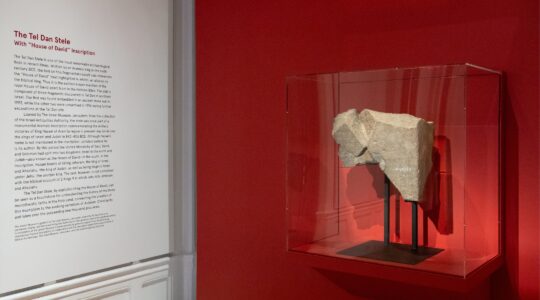Tucked into a corner of the Columbia University campus at the end of a long hallway, Elisheva Carlebach’s book-lined office is as quiet and serene as a library. But as soon as she begins to speak about her new book, “Palaces of Time” (Harvard), we’re transported to a world where few things are fixed or organized — not even the concept of time.
“Palaces of Time” explores the art and science of sifrei evronot, calendar booklets created by a group of scholars from the 15th to the 18th century. They were much like today’s almanacs, listing both Jewish holidays as well as those of the majority Christian or Muslim culture: market days, saints’ days and propitious times, based on astrology and folk wisdom, for activities like moving to a new house or bloodletting. Printed or, more commonly, copied by hand, they also served as instructional manuals for creating wall calendars that hung in synagogues or homes. In an age when the adoption of the Gregorian calendar shook the Christian world with new dates for major holidays, the accurate calculation of time was one of the few ways in which members of the Jewish minority could create a sense of stability for themselves.
Sifrei evronot were not made to last — but, incredibly, some have. Carlebach, professor of Jewish history, culture and society at Columbia and winner of the National Jewish Book Award and fellowships from the National Endowment for the Humanities and New York Public Library Center for Scholars and Writers, spoke with Text/Context about what sifrei evronot can tell us of the lives and concerns of the society that used them.
Text/Context: How did you become interested in these calendars?
Carlebach: I saw a calendar that was painstakingly written by hand in the 18th century and was just stunned that something so small and fragile had survived. That drew me to ask whether others had survived, and I began looking at calendar materials in collections of Judaica wherever I could find them. The calendar is something we all think we know about. It appears set, and we don’t tend to devote much thought to it, other than worrying about whether the holidays will be coming early or late this year. When I discovered that in the early modern period Jews had been intensely focused on the calendar, that it had been in fact unstable in various times and places, and that it had been a focus of Jewish creativity, I was drawn to it.
How has this study further informed your understanding of Jewish history?
It has shown me what a delicate balancing act Jews had to perform between maintaining their separate culture and integrating into the majority culture so they could function within that society and its economy. That balance was vivid in the pages of the calendar, and I think it’s a reflection of the experience of Jews throughout history.
How did the Jewish practice of marking time according to Jewish months influence relationships with neighboring communities who followed their own calendars?
There are many things that made Jews in pre-modern times seem different to their neighbors: they sometimes spoke a different language, dressed differently or were forced to wear identifying badges. Every one of those signs of difference could be erased or absent without touching a person’s inherent Jewishness. But the calendar Jews followed — their different day of rest, business as usual on Christian holidays — this was something of an indelible marker of difference. Their neighbors sometimes misinterpreted and took Jewish celebrations as a sign of insensitivity.
You write that “… to readers in the early modern period, the traditional Jewish sabbath could stand as a metaphor for the entire Jewish calendar.” How so?
Marking a day of rest differently than the society around them marks Jews, and Shabbat is the most frequently occurring day on the calendar. But it’s much more than that. The Sabbath is the covenant that’s supposed to testify to the creation and relationship between God and the world, God and His people, who reflect God’s own actions by taking a day of spiritual rest, and that’s really what everything about the calendar is. It’s about sanctifying time. It’s about taking this flowing, unmarked, abstract idea — even philosophers struggle for the right way to describe time — and trying to endow it with qualities that help us transcend the mundane daily-ness of our lives.
How did sifrei evronot differ from calendars used by Christians and Muslims?
Support the New York Jewish Week
Our nonprofit newsroom depends on readers like you. Make a donation now to support independent Jewish journalism in New York.
They really don’t differ in form. In each of these traditions, a calendar is intended to convey a lot of useful information in a very compact form. The difference is that the Jewish calendar in the Christian world includes the Christian calendar, and the Jewish calendar in the Muslim world includes the Muslim calendar — but not vice versa. It would not be necessary for the majority culture to know the highways and byways of the minority culture, so it only works one way in that sense.
How did the invention of print influence the popularity and design of sifrei evronot?
I think sifrei evronot, which began as a manuscript tradition after print had already been introduced in the mid-1500s, might be a response to print, a way of saying that constructing or calculating the calendar is becoming a lost art. Once upon a time you had to look at the moon. Then a calendar became something that everybody had a formula for and learned how to calculate. But now that it’s available in printed form, and you can produce thousands of copies in a very short time, what’s left for Jews to do to fulfill the mitzvah of sanctifying time and counting it? I think this was a way of trying to recover a creative way of hiddur mitzvah, the beautifying of the mitzvah of calculating time.
The printed calendars are inferior in every way to the manuscripts. They’re never illustrated. Both pocket and wall calendars came to be a staple of printers and booksellers because of something wonderful about them: people need to buy them every single year! Some were probably sold by peddlers — think of Sholem Aleichem’s peddler, Mendele the Bookseller, who carried “lukhes,” calendars, as part of his regular merchandise.
What kinds of illustrations and imagery did they use?
After looking at many sifrei evronot, I came to realize that there’s an iconographic vocabulary that wants to convey the notion that the Jewish calendar was divinely inspired and granted. That’s what my cover image is about — the biblical figure of Issachar who goes up to the heavens and comes back down with the knowledge needed, here represented by an hourglass. Another is of Rabban Gamliel receiving a message from God telling him exactly how many days are in a month and a leap month. A few have Moses, because God showed him the moon and said, this is the way it’s supposed to look when you sanctify the month. Another theme is the beginning of time — Adam, Eve and the serpent — because that’s when human history, and therefore the accounting for time, begins. Until then, the world was chaos and there is no accounting for time.
You write about clever and occasionally subversive puns and wordplay encoded in sifrei evronot. Why was this done?
That really brings us right back full circle to where we began, which is the need of members of a small minority to both integrate and encompass knowledge of the majority’s calendar at the same time they needed to distance themselves from some of its theological concepts. It’s kind of an alert. It was a way of indicating that while Jews had to know the details of the Christian calendar and were enveloped by its culture, they used a mocking humor to show that they did not take it to heart. It was a distancing mechanism from the powerful dominant religious culture. Some of the puns are quite irreverent, and were meant as little internal jokes. For example, when noting St. Thomas’ Day, they would spell “tumas” in Hebrew letters, which could be read as “impure.” Writing about a virgin martyr, they’d write in Hebrew “pesula” (tainted one) instead of “besula” (virgin, according to the Ashkenazic pronunciation).
If a middle-class, 15th- or 16th-century European Jew were transported into the future, what might he or she think about how we mark “Jewish time” today?
On the one hand they would recognize the long-term survival of most of our major holidays without much change over millennia. On the other, they’d certainly be shocked at the technology that we have. Many of us don’t even consult a calendar in book or printed form any more. They’d be shocked by how advanced we’ve become, but also puzzled by how, despite the fact that we have managed to pinpoint time with such accuracy, we don’t have any more of it.
Harriet R. Goren, a web and print graphic designer for her own business, Harriet R. Goren Design, has put together more Jewish calendars than she can count.
The New York Jewish Week brings you the stories behind the headlines, keeping you connected to Jewish life in New York. Help sustain the reporting you trust by donating today.




